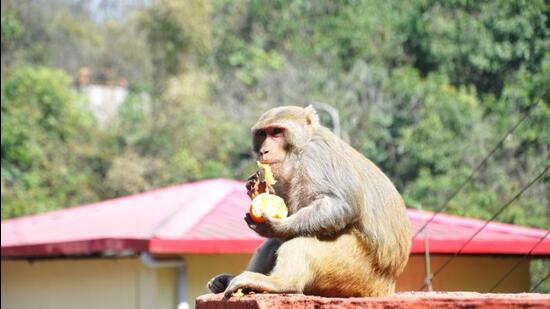Population of monkeys declines by 25%, langurs by 31% in U’khand: Report
The forest department sterilised 48,115 monkeys from 2015-16 till 2020-21in the rescue centres to tackle the monkey menace in the hilly areas of the state, according to the information shared by the then state forest minister Harak Singh Rawat in the state assembly last year.
A decrease of around 25% in the population of monkeys and 31% in the population of langurs has been reported in Uttarakhand, as per the census conducted by the state forest department.

According to the census, there are 1,10,481 monkeys and 37,735 langurs in the state.
“The state forest department conducted a survey of monkeys and langurs across the state in December 2021. The department covered 31 forest divisions of the state and areas adjoining human habitations. After the census, the data was sent to the Wildlife Institute of India, Dehradun, after which the final figures were released,” chief wildlife warden, Uttarakhand, Parag Madhukar Dhakate said.
Dhakate said of 1,10,481 monkeys, 28,420 are adult males, 35,127 adult females, 19,227 sub-adults, and 19,555 infants. Of 37,735 langurs, 9,596 are adult males, 11,839 adult females, 6,166 sub-adults, 6,363 infants, he added.
“Maximum 6,857 monkeys in the state were reported from Haridwar forest division, while 6,197 monkeys have been reported in Bageshwar and 5,735 in Dehradun. Maximum 3,219 langurs have been found in Corbett Tiger Reserve, followed by 2,964 langurs Badrinath area and 2,153 in Kalagarh Tiger Reserve,” he said.
According to forest officials, earlier the census of monkeys and langurs was held in the state in 2015, when 1,46,432 monkeys and 54,804 langurs were reported in the state.
One of the possible reasons for the decline in the population of monkeys, Dhakate said, is sterilisation as thousands of the simians were previously sterilised in the state.
“To check the population of monkeys, they were sterilised by the forest department at Chidiyapur animal rescue centre in Haridwar and Ranibag animal rescue centre in Nainital,” said the official.
The forest department sterilised 48,115 monkeys from 2015-16 till 2020-21in the rescue centres to tackle the monkey menace in the hilly areas of the state, according to the information shared by the then state forest minister Harak Singh Rawat in the state assembly last year.
On setting up of monkey enclosures in the state, the minister had stated that the government had no plans to set up monkey enclosures in all 13 districts but in five places across the state where about 40,000 monkeys would be kept after they are caught.
Wildlife Institute of India (WII) Dehradun scientist Qamar Qureshi who is working on developing a contraceptive for monkeys said many factors could be responsible for the decline in the simian population, including sterilisation operations. “But one needs to look into the way the census has been done, which areas have been covered, what is the error rate in the census. Then one can look into other factors to correlate the decline in the population of the monkeys and langurs in the state.”
AG Ansari, Ramnagar based wildlife expert said that the decrease in the number of monkeys and langurs is worrying. “Apart from sterilisation factor, human presence in forests is increasing and so is concretisation. In many areas, trees are also being cut. In lieu of this, the plantation is being done. But it takes 10 to 15 years for these plantations to become a forest. This is also affecting the habitat of wild animals, including monkeys. This could be one reason but a more detailed study is required to understand this decline, “ he said.
With a large percentage of the hill state under forest cover, monkeys often come near human habitations, roads and tourist spots in search of food. Given the limited scope for farming in the hilly state, monkeys have become enemies in the eyes of farmers. In the past, farmers in some areas of Kumaon even started agitations against the monkey menace, saying whatever little farm produce they have, is often destroyed by monkeys.
In 2015, students of a government school in Almora wrote 52 postcards to the chief justice Uttarakhand high court on monkeys barging into their classrooms and snatching away their food. Treating it as a PIL, the Uttarakhand high court then ordered the state government and forest department to take appropriate action in the matter.
Get Current Updates on India News, Lok Sabha election 2024 live, Election 2024 along with Latest News and Top Headlines from India and around the world.



